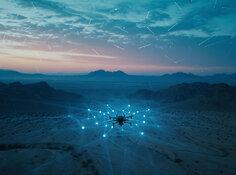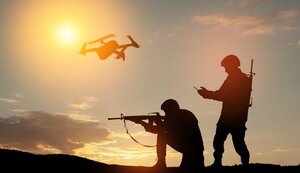Unmanned aerial vehicles (UAVs), or drones, are changing the face of warfare around the world, leading to increased demand for solutions to combat them.
One company watching the developments closely and expecting to be a leader in the field is Australia's DroneShield Ltd. (DRO:ASX; DRSHF:OTC), which develops and offers an array of end-to-end counterdrone solutions that combine its hardware products and its proprietary artificial intelligence (AI)-backed software.
"Today, there is this arms race," DroneShield Chief Executive Officer Oleg Vornik has said. "We are seeing an ongoing, rapid increase in drone threats. DroneShield is very much up in the leading pack to detect and take down those threats."
The theater for the technology is expanding at a rapid pace. According to a report by the nonpartisan group Vision of Humanity, drones have been "increasingly used by both state and non-state actors, with the number of drone strikes and associated fatalities rising significantly in the past five years."
According to an NPR piece, nowhere is that more evident than Ukraine, which has dramatically increased its production of UAVs since Russia invaded the country in 2022.
This year, the Ukrainian government allocated US$2 billion to produce at least 1 million first-person view (FPV) drones. President Volodymyr Zelenskyy has said the country has already surpassed that, contracting 1.5 million drones in the first three quarters of this year, NPR's Joanna Kakissis and Claire Harbage reported.
"(Zelenskyy) added that Ukraine is now capable of producing 4 million drones annually," they wrote. "The government, military, private companies, and regular citizens are all involved."
Drones are also "becoming an increasingly key platform in the Myanmar civil war and conflicts across the Middle East," Geopolitical Monitor reported. "Advanced militaries, including the Pentagon, are closely monitoring these theaters to refine their own drone strategies."
The Catalyst: New DoD Initiative Focuses on Small-Drone Threats
DroneShield's counterdrone systems have three functions, which they can carry out in any environment, in the air, on the ground, and at sea, as described in its August 2024 Investor Presentation. Counter unmanned aircraft systems (C-UAS) monitor situations in real-time using AI. They detect drones using their AI-powered optic and thermal sensing capabilities. They defeat threats with intelligent, responsive soft or hard kills.
To meet the specific needs of end users, DroneShield's systems are available in various configurations, from standalone and plug-and-play to cohesive and fully integrated. The hardware can be used while affixed to a site or while handheld by someone who is stationary or on the move. The company ensures that its products are practically applicable in real-life scenarios.
"Providing solutions that deliver a decisive advantage to our end users is what we strive for," DroneShield U.S. CEO Matt McCrann said in the release.
Shaw & Partners Analyst Abraham Akra and Bell Potter Analyst Daniel Laing expect DroneShield to grow sales throughout the rest of 2024 and into 2025, each wrote in their most recent research report. Both have a Buy rating on the stock.
U.S. Defense Secretary Lloyd Austin recently announced that the next phase of the Pentagon's drone program would focus on countering threats from small drones, Defense News reported.
"As with first round of the program — which aims to deliver thousands of low-cost drones by next summer — Replicator 2 will work with the military services to identify existing and new capabilities that could be scaled to address gaps in their counter-drone portfolio," Defense News' Courtney Albon wrote. "Replicator 2 is particularly focused on fixed-site counter-small uncrewed aerial systems, or C-sUAS, needs, which means protecting installations and facilities."
DroneShield's McRann told Streetwise Reports that it's good that the Defense Department is looking to accelerate the Replicator 2 initiatives and funding for them "while still planning and allocating properly with FY26 funds."
"It shows firm understanding of the serious and quickly evolving threat drones present in the battlespace and acknowledgement of the need to shift priorities to properly arm the warfighter for those threats," he continued.
He said while the company cannot comment on its activity with the department, "With the proven performance, production rates, and cost-effectiveness of our solutions, we are well positioned to meet the needs identified and deliver commercial off the shelf Counter-UAS capabilities at scale."
Could Lasers be a Solution?
One form of anti-drone technology that looks more like science fiction is also getting attention. After decades of development, some militaries say lasers could prove effective at shooting down drones.
The Wall Street Journal reported recently that the U.S. has already deployed them in the Middle East to shoot down UAVs. The Army declined to give details on the operations.
The United Kingdom announced earlier this year that its DragonFire laser can hit a target the size of a coin from a kilometer away.
But "the path to laser weapons has been long and costly," author Alistair MacDonald wrote for The Journal. "Militaries have been experimenting with using lasers since U.S. physicists created them in the early 1960s."
DroneShield CEO Vornik told Streetwise Reports that the trend is "promising."
"Lasers are not the tech for mass adoption, however," he said. "They are expensive (the cheapest units are still millions of dollars apiece), dangerous (they will take your eye out if accidentally pointed at you), and can't actively deal with swarms. However, we are engaging with laser companies to integrate them into our multi-sensor DroneSentry solution."
US Government Is Co.'s Largest Client
DroneShield's customers include military and intelligence, government, law enforcement and entities protecting infrastructure and assets, including airports, stadiums, ports, correctional facilities, high-profile events, commercial enterprises, energy production sites and more. The U.S. government, which has been DroneShield's largest client, accounting for about two-thirds of its business last year, is expected to remain so in the near future, said Vornik.
The company continues to build its customer base, noted the CEO, through sales teams on the ground in the U.S., Europe, the Middle East and soon, South America too.
Shaw & Partners Analyst Abraham Akra and Bell Potter Analyst Daniel Laing expect DroneShield to grow sales throughout the rest of 2024 and into 2025, each wrote in their most recent research report. Both have a Buy rating on the stock.
Sector Spending on the Rise
The emerging global counterdrone market is forecasted to expand at a compound annual growth rate of 26% between 2023 and 2032, according to Global Market Insights, reaching US$15.3 billion (US$15.3B) in value, up from US$1.9B during the period.
Another prediction by Markets and Markets expects the market to hit US$7 billion by 2029.
"The changing nature of warfare, the growing number of illicit activities, increasing UAS sightings in international airports, government investments and initiatives, growing infrastructure in smart cities, and ongoing developments in anti-drone systems are some of the major factors contributing to the global growth of the anti-drone industry," the firm reported.
Rising government expenditures on the defense and aerospace industry are also forecasted to impact the sector. A Sept. 12 Wealth Daily article reported the U.S.' fiscal year 2025 defense budget starts at about US$895B and in the next few years, is likely to be US$1 trillion. NATO is already set to spend more than that this year.
 Streetwise Ownership Overview*
Streetwise Ownership Overview*
DroneShield Ltd. (DRO:ASX; DRSHF:OTC)
"In fact, a record 18 NATO members are on track to hit the alliance's oft-stated target of 2% of GDP — up from just three in 2014. And some of those countries — those most threatened by Russia’s aggression — are exceeding it," the reporter wrote.
Ownership and Share Structure
Management and insiders own 6.88% of the company, according to DroneShield. CEO and Managing Director Oleg Vornik owns 1.63% with 15 million (15M) options, on a fully diluted basis. Nonexecutive Chairman Peter James holds 0.43% with 935,000 shares and 3M options, on a fully diluted basis. Nonexecutive Director Jethro Marks owns 0.16%, with 1.5M options, on a fully diluted basis.
According to Reuters, about 10% of the company is held by strategic investors.
Epirus Inc. is the largest shareholder, with 2.12% or 18.5M shares, Reuters said.
Structurally, DroneShield has 872.12M outstanding shares and 782.40M free float traded shares.
Its market cap is AU$898.28 million. Its 52-week range is AU$0.26−2.72 per share.
| Want to be the first to know about interesting Technology investment ideas? Sign up to receive the FREE Streetwise Reports' newsletter. | Subscribe |
Important Disclosures:
- As of the date of this article, officers and/or employees of Streetwise Reports LLC (including members of their household) own securities of DroneShield Ltd.
- Steve Sobek wrote this article for Streetwise Reports LLC and provides services to Streetwise Reports as an employee.
- This article does not constitute investment advice and is not a solicitation for any investment. Streetwise Reports does not render general or specific investment advice and the information on Streetwise Reports should not be considered a recommendation to buy or sell any security. Each reader is encouraged to consult with his or her personal financial adviser and perform their own comprehensive investment research. By opening this page, each reader accepts and agrees to Streetwise Reports' terms of use and full legal disclaimer. Streetwise Reports does not endorse or recommend the business, products, services or securities of any company.
For additional disclosures, please click here.








































